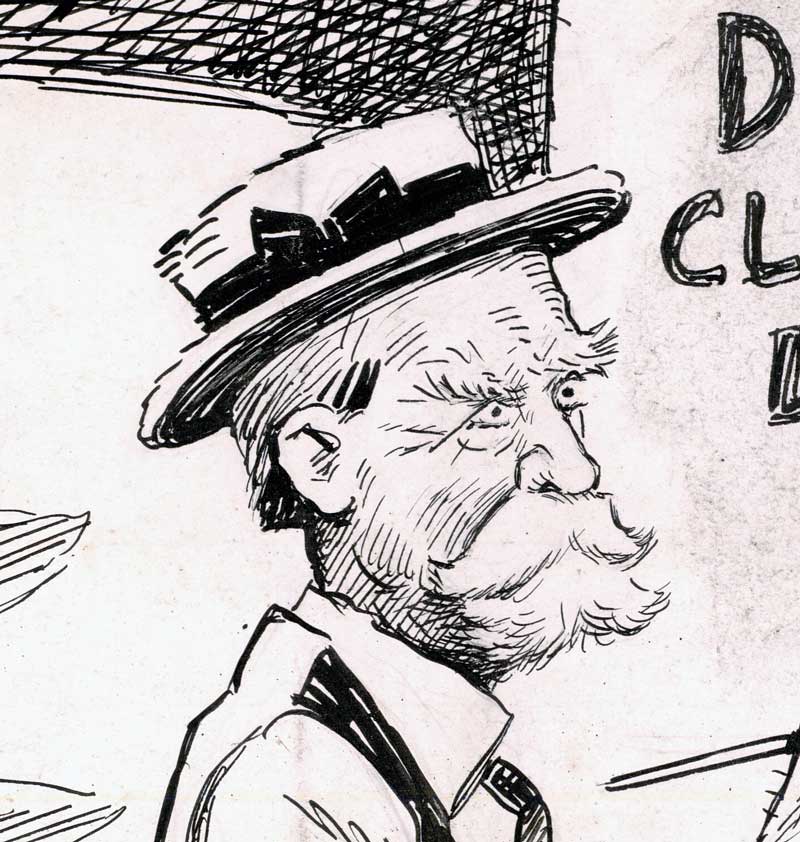
“Touching Up the Old Sign” (August 29, 1921)
by William Charles (WC) Morris (1874-1848)
17 x 22 in., ink on board
Coppola Collection
WC Morris taught himself to draw at age 28. For nine years, Morris worked was a cartoonist for the Spokane Spokesman-Review in Washington. In 1913, tired of having his work censored by the paper’s managers, he moved to New York City and did freelance work for Life, Judge, Outlook, and Harper’s Weekly, before being hired by the George Matthew Adams Service, a newspaper syndicate with publications all across the country. Morris’s work was also widely reproduced in American and European magazines, including the popular satirical journal Puck. He even ventured into the new art of animated cartoons.
In 1899, Secretary of State John Hay watched China, following the devastation of the Opium Wars and growing rebellion, get its entire periphery sub-divided by the world powers: Russia, Japan, Germany, France, Italy, and Great Britain. These powers laid claim to special privileges in various parts of the country, called spheres of influence, a process that recalled the subjugation of Africa and suggested that China might be similarly partitioned. The United States, still young as a player on the world stage, was shut out of this new scramble created barriers to American trade in China.
Buoyed by the recent US victory over Spain and the possession of both Pacific and Central American assets, Hay dispatched his famous Open Door Notes to the major powers. The policy proposed that each of the powers respect the principle of equal commercial opportunity in the spheres of influence. The notes neither challenged the spheres’ existence nor demanded equal access for American investment. The Open Door policy concerned the transport and selling of American goods. The gist of the policy ended up shifting the US international interests from colonial expansion to economic influence.
The Open Door did not result in the commercial goldmine its creators imagined. And the lack of actual policy led to infighting among China’s occupiers and a growing resentment to all of this foreign meddling. There is a direct line between the Open Door Policy, international squabbling, and the Boxer rebellion in which a purge of foreigners in China, including by assassination, was carried out. The line continues, from the Boxer Rebellion to numerous smaller rebellions and the eventual end of the imperial age with the demise of the Qing in 1911.
Japan took the greatest advantage of the turmoil in China, while the US became the champion of its sovereign rights. Japan pressed ahead with terms that centered on its economic privileges, and China yielded with little delay. The US declared that it would not recognize any agreement that violated Chinese sovereignty or conflicted with the Open Door.
At the 1919 Versailles Conference, Wilson demanded that the Japanese relinquish control over Shandong province and affirm Chinese sovereignty. Japan refused. Wilson backed down, provoking fierce criticism in China.
Warren Harding, following Wilson, opted to deal with rivalries in China by gathering all of the great powers together to work out their differences and establish new principles of conduct in the Far East. The result, the Washington Conference of 1921–1922, was an important diplomatic victory for the United States and a major—if temporary—breath of life for the Open Door policy.
By 1921 warship construction consumed fully one-third of Japan’s budget. Fearing a naval arms race, Secretary of State Charles Hughes invited the foreign ministers of eight maritime nations to Washington to reduce tensions in the Far East. The Japanese government, content to pursue its aims peacefully, entered into all three of the resulting treaties. By far the most important treaty for the future of the Open Door policy was the Nine-Power Treaty that called for noninterference in China’s internal affairs and respect for the Open Door principle.
The treaty was the most promising assertion of the Open Door policy since Hay’s notes. The Hughes agreement bound all of the principal powers and even reflected input from a full-fledged Chinese delegation.



